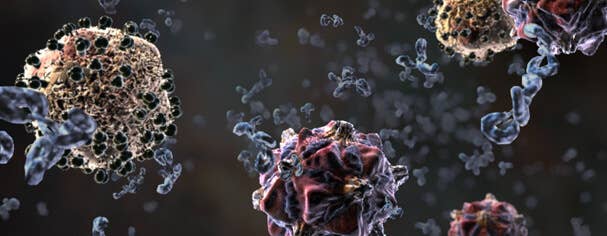The Scoop on Zirus from CEO David Perryman

Share
If the Home Alone movies taught me anything (and that's doubtful to begin with) it's that defeating the bad guys goes hand in hand with well-laid traps. Well, there are few bad guys as agile, as devious, and as skilled as viruses. Now, Georgia based biotech firm Zirus has found a new way to fight viral infections: don't target the virus, target the human host cell. Get 'em where they hope to live. Whereas typical viral medications aim to attack a viral particle (virion) directly, Zirus is helping create medications that will make your cells inhospitable to viral infection. It's a revolutionary new idea and I got to pick the brain of Zirus CEO David Perryman to learn more.

Zirus isn't making medicine directly, they're researching the way viruses exploit cells. But what kind of medications might Zirus' research make possible? Well, treatments for the common cold for starters. Herpes, SARS, Hepatitis C, those could all be medicated. How about a single drug that could help you fight off Ebola, HIV, or the Flu. Yep, Zirus technology could be used to target not just one virus, but a whole family of viruses.
When you can target entire families of viruses, you can prepare for diseases that haven't even developed yet. Vaccines and standard anti-viral meds can't do that. As Perryman says, "There's no way you can vaccinate against the unknown." In this way, Zirus based meds are superior to vaccines. So now we may have a pro-active response to the threats of bio-terrorism. And in-vitro experiments show that the techniques developed by Zirus can prevent viral caused cell destruction with every virus tested to date. That's right, these medications could be nearly universal in their application.
How does it all work?
Vaccines prepare your immune system, and traditional anti-viral meds attack the virion directly. Zirus discovered a third avenue of approach: make the host-cell construction and assembly mechanisms impossible for viruses to break-into and corrupt. How? The key is cell proteins.
Viruses use proteins in host cells to reproduce. They're the microscopic version of James Bond. Break in, hijack and destroy, then skip town and do it again. But what if the virion couldn't break into a cell? What if there wasn't a sexy protein for our James Bond virus to corrupt? That's the whole concept behind Zirus: find the ways that viruses enter and hijack cells, and then remove those elements so that there's no pathway for the virus to reproduce. Derail the reproduction process and a virus (or James Bond) is basically powerless.

Zirus has a new application of a proprietary technology called gene trap. Gene trap is actually a retrovirus, genetically designed to enter into test cells and change just one single gene. Apply it to enough cells and you'll have one cell for each gene in the human genome. Every cell has a different gene that's been messed with. Many of these cells will die (random changes to the genome tend to have that effect), but some will live.
So what does the genetic change do? Well, many will alter the proteins in a cell. Zirus exposes each of these living cells to a virus that is typically 100% lethal. A few select cells survive the viral exposure. These remaining cells had a genetic change that altered proteins and kept the virus from killing them. If you've tested the whole genome, you have found all such possible proteins.
"Can I tell you [something] really cool about gene trap...it's a small retrovirus. The trap itself is a modified virus...So it's really virus versus virus to provide us with this information...That sort of cleverness [engineered by our founding scientist Don Rubin] blows me away." ---David Perryman, 2009
You could, theoretically, alter someone's DNA so that they never produce these virus-friendly proteins, but who knows the long term effects or dangers of that. Instead of genetic doping, we're going to see doctors affect those proteins in a temporary way through drugs. The medications that scientists would develop will target those proteins and the genes encoding the proteins and either suppress their production (called down-regulating) or disrupt their use (through small molecule sized inhibitors). According to Perryman, " ...Making drugs that inhibit the protein's functions are the nearest term, most durable, most likely drugs."
The Long Term Stability of a Three-Legged Stool

Be Part of the Future
Sign up to receive top stories about groundbreaking technologies and visionary thinkers from SingularityHub.


David Perryman is quick to point out the benefits and limits of Zirus' discoveries. Medications that target host cell proteins are less likely to be defeated by viral mutations. They can target wide ranges of viruses all at once to create broad spectrum antiviral drugs. They may work against viruses that haven't even been seen yet. These advantages place protein-inhibiting medications above the other two common treatments: vaccines and anti-viral drugs. Perryman, however, likens the three options as legs of a stool. Some may be stronger choices than others, but you need all three to keep things stable.
That's because there are some drawbacks to protein-inhibiting meds. First, toxicity. Messing with cellular proteins, even temporarily, isn't always healthy for a cell. While the most disruptive changes were eliminated during the gene trap (remember all those cells that died in the beginning?) other problems could still arise. The second major drawback: research time. Finding a protein is not the same thing as finding the drug that will affect that protein. Finally, no matter how wonderful gene trap directed medication could be, viruses are likely to eventually find a way around them.
"There's always a concern with any drug about toxicity. When you think about the drugs you already take...they're affecting our proteins and [cell] processes in some way. So what we're doing is making [anti]viral drugs that are more like all other drugs." ---David Perryman, 2009
Zirus isn't too concerned about toxicity, however. With a whole genome of proteins to test, there's bound to be several options for each virus. You can target the protein whose temporary inhibition will have the least toxic effect on a cell. In fact, Zirus is confident that the proteins they help choose will result in effective new drugs that have relatively low toxicity.
As for research time, there is a huge host of medications that are already approved by the FDA, such as some for high blood pressure. Some, if not many, of these may be effecting proteins that Zirus could point out as virally important. Already, Zirus has worked with its partners to develop one such medication as a treatment against influenza. Because it's already FDA approved, the medicine just has to be shown to be effective in this new use. Perryman thinks we may see re-purposing of existing medications in the next few years.
Which is a good thing, because developing entirely new medications may take 10 to 15 years. That's all part of the plan, though. Current medications, vaccinations and anti-viral cocktails are working well enough to hopefully see us through as Zirus builds that third leg of the stool. Once the leg is in place, a combination of vaccines, anti-virals, and human protein inhibitors will allow us to combat viruses in a holistic way
Ziruses and Viruses of the Future
"When you think about antibiotics, ...it's sort of similar. We started with penicillin and we've evolved to all these...broad spectrum antibiotics...Now [we] basically have the same kind of technology [platform] with viruses." ---David Perryman, 2009
While the gene trap technology is an amazing tool for learning more about combating viruses, Zirus isn't a traditional pharmaceutical company. They aren't going to be making medications themselves. Instead, Perryman sees Zirus as becoming a hub for viral research. The company will point the way to promising new proteins and existing drugs that could be used in viral medications. It already works with several major universities, the CDC, NIH, and the biodefense part of the NIADA. In the future, Zirus will help combat not just the commercially important viruses like the flu and HIV, but all viruses that have the potential to harm us.
Here at the Hub, we like ideas that attack a problem from a completely new angle: computers built like brains, building materials that can think, or fuel from poop. Zirus is one of those kinds of ideas. With a whole new method to combat viruses, the gene trap technology will radically improve our response to viral illness whether natural or lab manufactured. Proactive research, finding ways to combat viruses before they are even discovered, further insulates us against global catastrophe. No viral treatment is perfect, but Zirus provides a great line of defense. You almost feel sorry for the bad guys.
"There's no limits because all viruses...need to exploit our cells, our factories, to reproduce themselves...We can affect any virus. It's doable." ---David Perryman, 2009
[All photos provided courtesy of Zirus]
Related Articles

Single Injection Transforms the Immune System Into a Cancer-Killing Machine

This Light-Powered AI Chip Is 100x Faster Than a Top Nvidia GPU

This Week’s Awesome Tech Stories From Around the Web (Through December 20)
What we’re reading